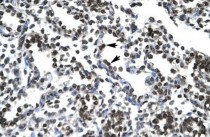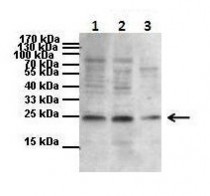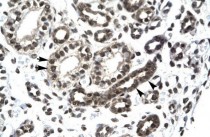ARG10649
anti-PTHLH antibody
anti-PTHLH antibody for IHC-Formalin-fixed paraffin-embedded sections,Western blot and Human,Mouse
Overview
| Product Description | Rabbit Polyclonal antibody recognizes PTHLH |
|---|---|
| Tested Reactivity | Hu, Ms |
| Predict Reactivity | Cow, Rat, Dog, Goat, Gpig, Hrs, Rb |
| Tested Application | IHC-P, WB |
| Host | Rabbit |
| Clonality | Polyclonal |
| Isotype | IgG |
| Target Name | PTHLH |
| Antigen Species | Human |
| Immunogen | Synthetic peptide around the center region of Human PTHLH. |
| Conjugation | Un-conjugated |
| Alternate Names | Parathyroid hormone-related protein; PTH-rP; PLP; PTHrP[107-139]; PTHRP; Parathyroid hormone-like protein; PTHR; PTHrP; HHM; BDE2 |
Application Instructions
| Predict Reactivity Note | Cow: 93%; Dog: 100%; Goat: 93%; Guinea Pig: 100%; Horse: 100%; Human: 100%; Mouse: 93%; Rabbit: 100%; Rat: 100% | ||||||
|---|---|---|---|---|---|---|---|
| Application Suggestion |
|
||||||
| Application Note | * The dilutions indicate recommended starting dilutions and the optimal dilutions or concentrations should be determined by the scientist. | ||||||
| Positive Control | HepG2 cell |
Properties
| Form | Liquid |
|---|---|
| Purification | Purification with Protein A. |
| Buffer | PBS, 0.09% (w/v) Sodium azide and 2% Sucrose. |
| Preservative | 0.09% (w/v) Sodium azide |
| Stabilizer | 2% Sucrose |
| Concentration | 0.5 - 1 mg/ml |
| Storage Instruction | For continuous use, store undiluted antibody at 2-8°C for up to a week. For long-term storage, aliquot and store at -20°C or below. Storage in frost free freezers is not recommended. Avoid repeated freeze/thaw cycles. Suggest spin the vial prior to opening. The antibody solution should be gently mixed before use. |
| Note | For laboratory research only, not for drug, diagnostic or other use. |
Bioinformation
| Database Links |
Swiss-port # P12272 Human Parathyroid hormone-related protein |
|---|---|
| Gene Symbol | PTHLH |
| Gene Full Name | parathyroid hormone-like hormone |
| Background | The protein encoded by this gene is a member of the parathyroid hormone family. This hormone, via its receptor, PTHR1, regulates endochondral bone development and epithelial-mesenchymal interactions during the formation of the mammary glands and teeth. It is responsible for most cases of humoral hypercalcemia of malignancy, and mutations in this gene are associated with brachydactyly type E2 (BDE2). Alternatively spliced transcript variants have been found for this gene. There is also evidence for alternative translation initiation from non-AUG (CUG and GUG) start sites, downstream of the initiator AUG codon, resulting in nuclear forms of this hormone. [provided by RefSeq, Nov 2013] |
| Function | Neuroendocrine peptide which is a critical regulator of cellular and organ growth, development, migration, differentiation and survival and of epithelial calcium ion transport. Regulates endochondral bone development and epithelial-mesenchymal interactions during the formation of the mammary glands and teeth. Required for skeletal homeostasis. Promotes mammary mesenchyme differentiation and bud outgrowth by modulating mesenchymal cell responsiveness to BMPs. Upregulates BMPR1A expression in the mammary mesenchyme and this increases the sensitivity of these cells to BMPs and allows them to respond to BMP4 in a paracrine and/or autocrine fashion. BMP4 signaling in the mesenchyme, in turn, triggers epithelial outgrowth and augments MSX2 expression, which causes the mammary mesenchyme to inhibit hair follicle formation within the nipple sheath (By similarity). Promotes colon cancer cell migration and invasion in an integrin alpha-6/beta-1-dependent manner through activation of Rac1. Osteostatin is a potent inhibitor of osteoclastic bone resorption. [UniProt] |
| Calculated MW | 20 kDa |
| PTM | There are 3 principal secretory forms, called PTHrP[1-36], PTHrP[38-94], and osteostatin (PTHrP[107-139]) arising from endoproteolytic cleavage of the initial translation product. Each of these secretory forms is believed to have one or more of its own receptors that mediates the normal paracrine, autocrine and endocrine actions. |
Images (4) Click the Picture to Zoom In
-
ARG10649 anti-PTHLH antibody IHC-P image
Immunohistochemistry: Paraffin-embedded Human lung stained with ARG10649 anti-PTHLH antibody at 4.0 - 8.0 µg/ml dilution. Magnification: 400X.
-
ARG10649 anti-PTHLH antibody WB image
Western blot: 30 - 40 µg of 1) HK-2 (Human renal tubuloepithelial cell), 2) MC3T3-E1 (Mouse osteoblast-like cell), and 3) MLO-Y4 (Mouse osteocyte-like cell) lysates stained with ARG10649 anti-PTHLH antibody at 1:1000 dilution.
-
ARG10649 anti-PTHLH antibody IHC-P image
Immunohistochemistry: Paraffin-embedded Human kidney stained with ARG10649 anti-PTHLH antibody at 4.0 - 8.0 µg/ml dilution. Magnification: 400X.
-
ARG10649 anti-PTHLH antibody WB image
Western blot: HepG2 cell lysate stained with ARG10649 anti-PTHLH antibody at 2.0 µg/ml dilution.









